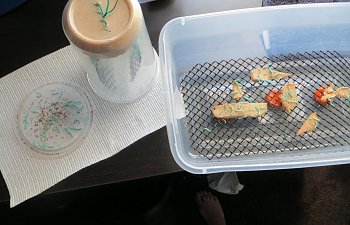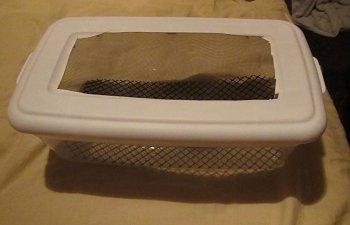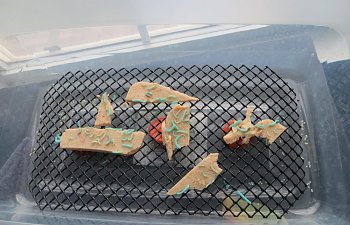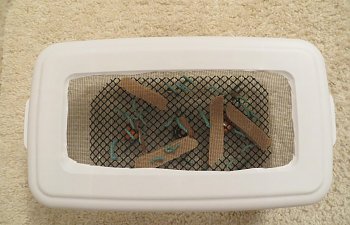After reading, "What came first, the hornworm or the egg?" you will come to the step described below.
When the hornworms grow big enough to move, I then transfer them from the deli cup to a modified tupperware container. I use the sterilite 6Qt (5.7 L) Tupperware containers that state they are for shoe storage. Any Tupperware that is around that size should do. I then cut out the lid and hot glue some screen to it as shown below. I also cut some gutter guard (http://www.lowes.com/pd_11632-205-85198_0__?productId=3009380&Ntt=gutter+guard&pl=1¤tURL=?Ntt=gutter+guard&facetInfo=) to place in the bottom. I also put bottle caps in the bottom to raise the gutter guard up. This layer of gutter guard allows the poo to fall through and makes daily cleaning easier.




This is where I will grow the worms while they are fed off and until they are ready to pupate.
I store the hornworm chow in the refrigerator and only put enough for them to eat each day in the container. This helps to ensure the food is fresh and does not get contaminated. When I add fresh food I remove all of the old food and clean the container. Proper cleaning and maintenance will ensure healthy hornworms.
I also take out a few that I plan to feed off within the next couple days and gut load them with greens, carrots and red bell peppers. They will readily eat many of your typical gut loading veggies.
If you need to slow down the growth of the worms in order to prolong the time you can feed them, you can put them in the refrigerator. I usually put them in a mini frig I have set at 50 degrees. I have read that they can go in for up to 2 days; however I have never put them in for more than a day at a time. I will put them in for a day and then leave them out for a day.
If you plan to breed them you may also want to keep them on a light cycle. Longer days, around 14 hours, promote more rapid development. Shorter days, 12 hours or less, could result in them going in to diapause once pupated and this could last for months.
In the next post I will cover what to do when it is time for them to pupate.
Part 3 Hornworms pupating
When the hornworms grow big enough to move, I then transfer them from the deli cup to a modified tupperware container. I use the sterilite 6Qt (5.7 L) Tupperware containers that state they are for shoe storage. Any Tupperware that is around that size should do. I then cut out the lid and hot glue some screen to it as shown below. I also cut some gutter guard (http://www.lowes.com/pd_11632-205-85198_0__?productId=3009380&Ntt=gutter+guard&pl=1¤tURL=?Ntt=gutter+guard&facetInfo=) to place in the bottom. I also put bottle caps in the bottom to raise the gutter guard up. This layer of gutter guard allows the poo to fall through and makes daily cleaning easier.




This is where I will grow the worms while they are fed off and until they are ready to pupate.
I store the hornworm chow in the refrigerator and only put enough for them to eat each day in the container. This helps to ensure the food is fresh and does not get contaminated. When I add fresh food I remove all of the old food and clean the container. Proper cleaning and maintenance will ensure healthy hornworms.
I also take out a few that I plan to feed off within the next couple days and gut load them with greens, carrots and red bell peppers. They will readily eat many of your typical gut loading veggies.
If you need to slow down the growth of the worms in order to prolong the time you can feed them, you can put them in the refrigerator. I usually put them in a mini frig I have set at 50 degrees. I have read that they can go in for up to 2 days; however I have never put them in for more than a day at a time. I will put them in for a day and then leave them out for a day.
If you plan to breed them you may also want to keep them on a light cycle. Longer days, around 14 hours, promote more rapid development. Shorter days, 12 hours or less, could result in them going in to diapause once pupated and this could last for months.
In the next post I will cover what to do when it is time for them to pupate.
Part 3 Hornworms pupating
